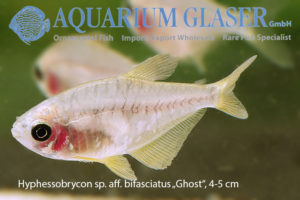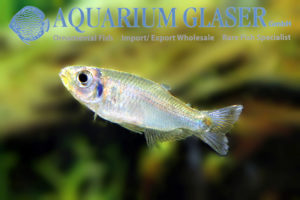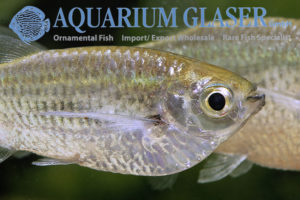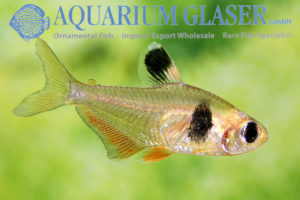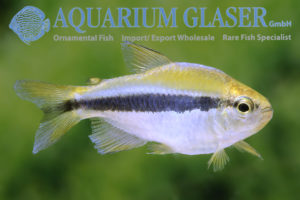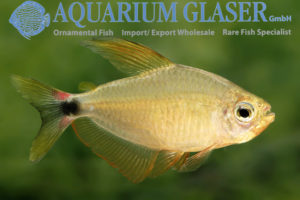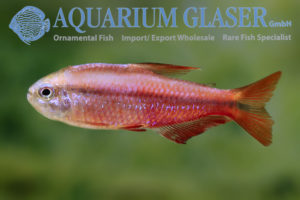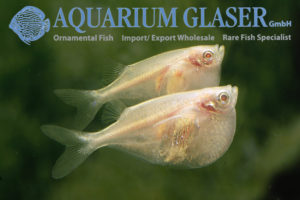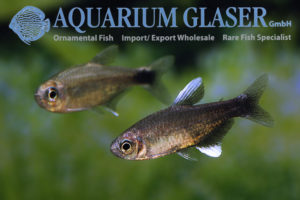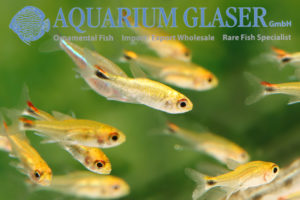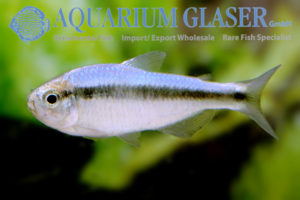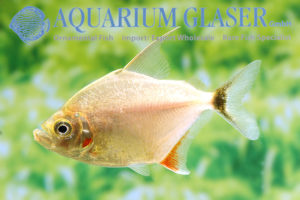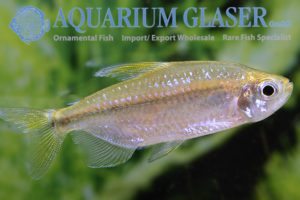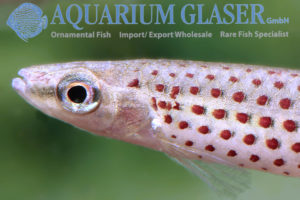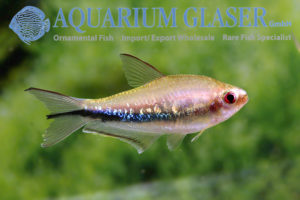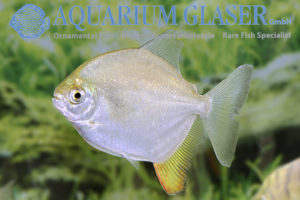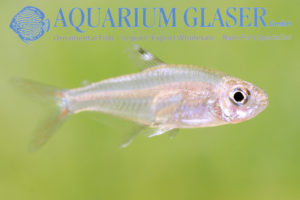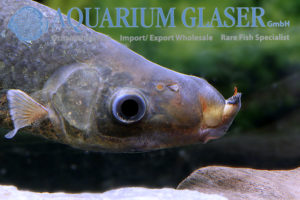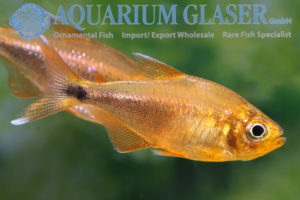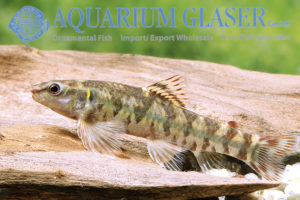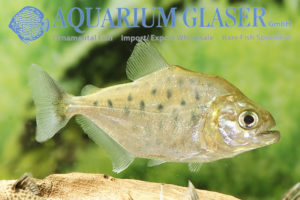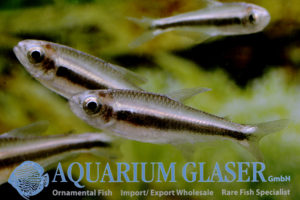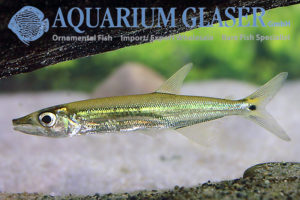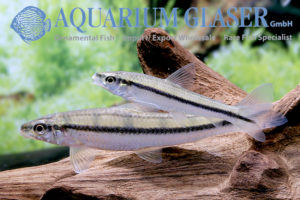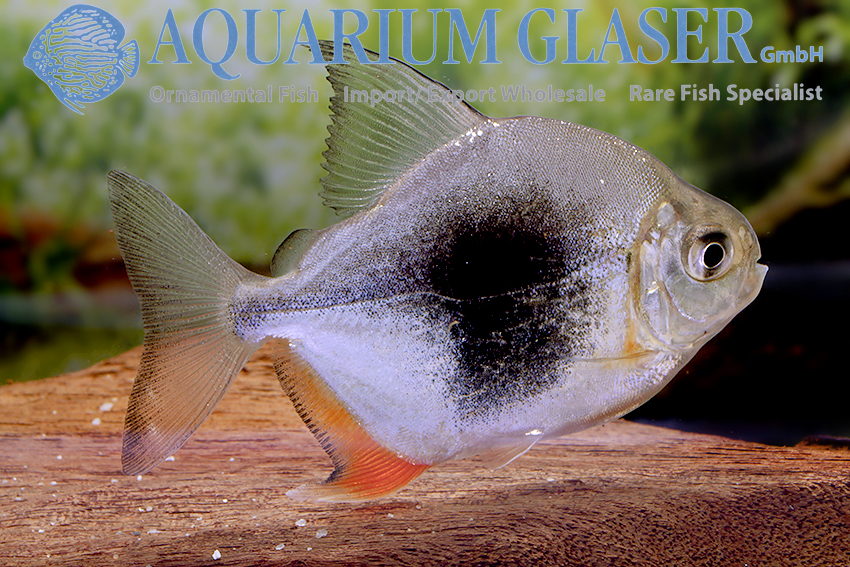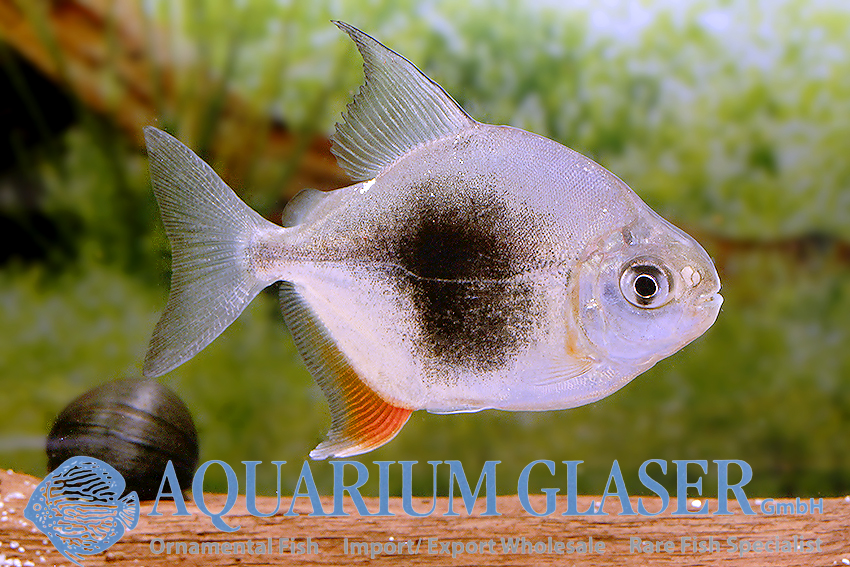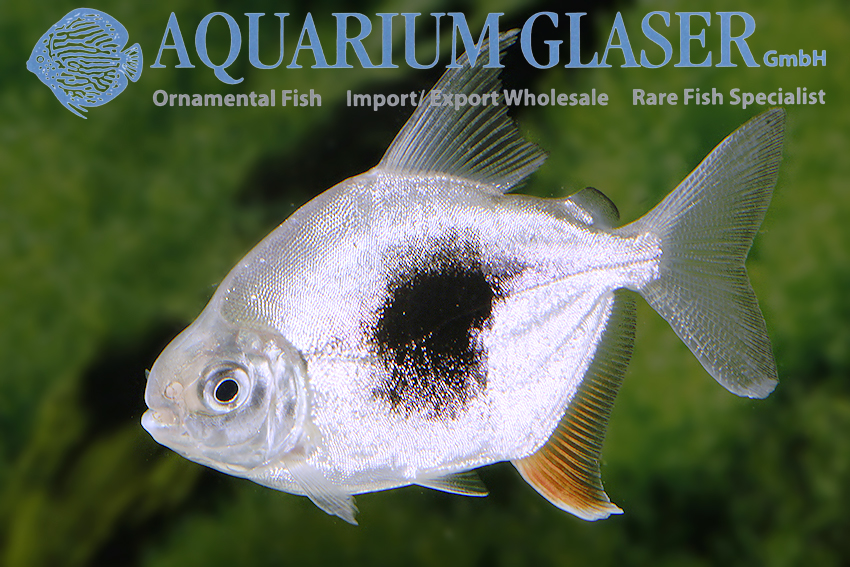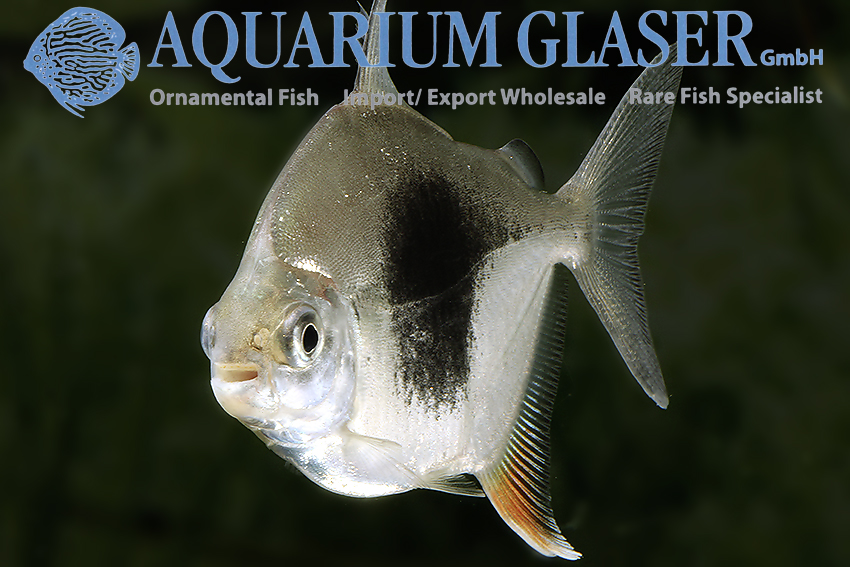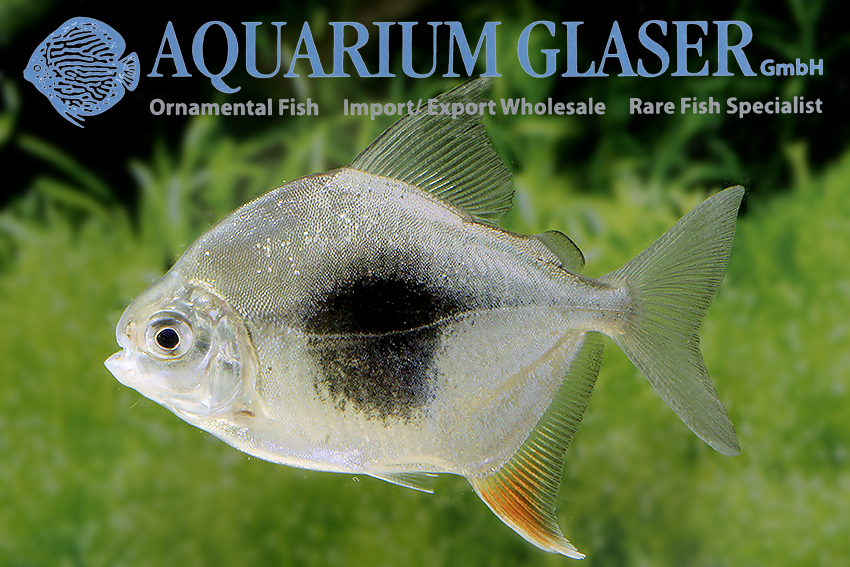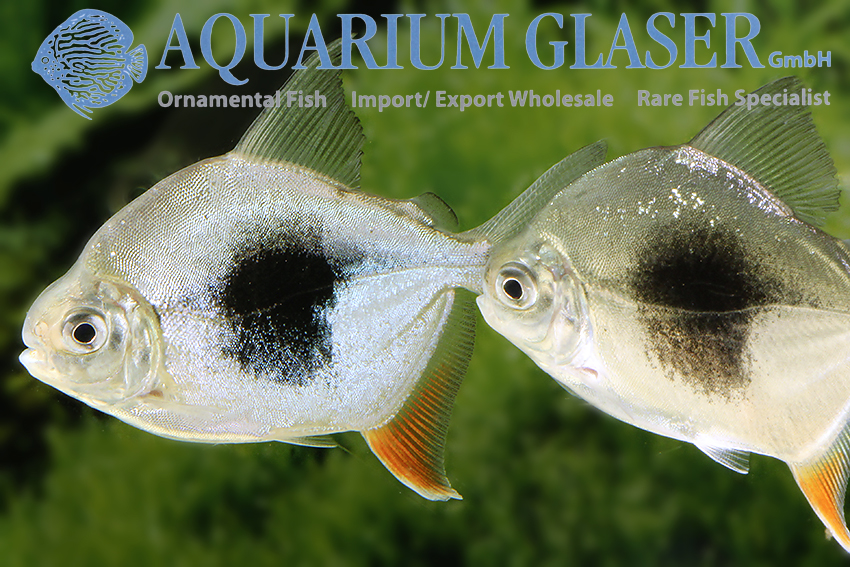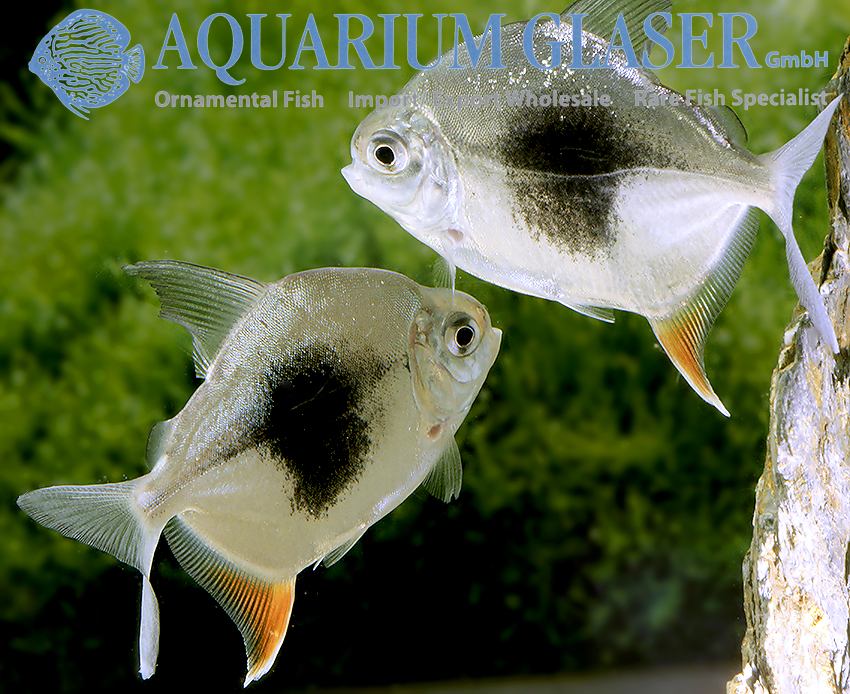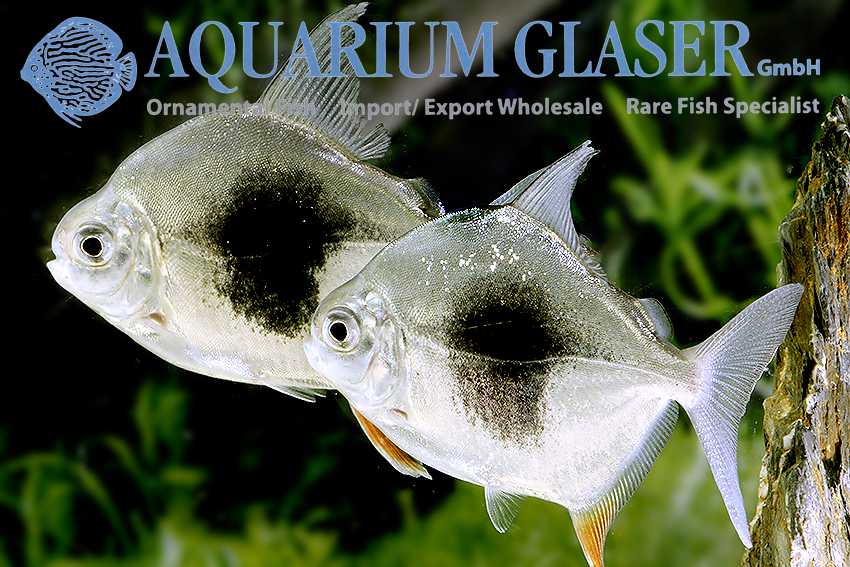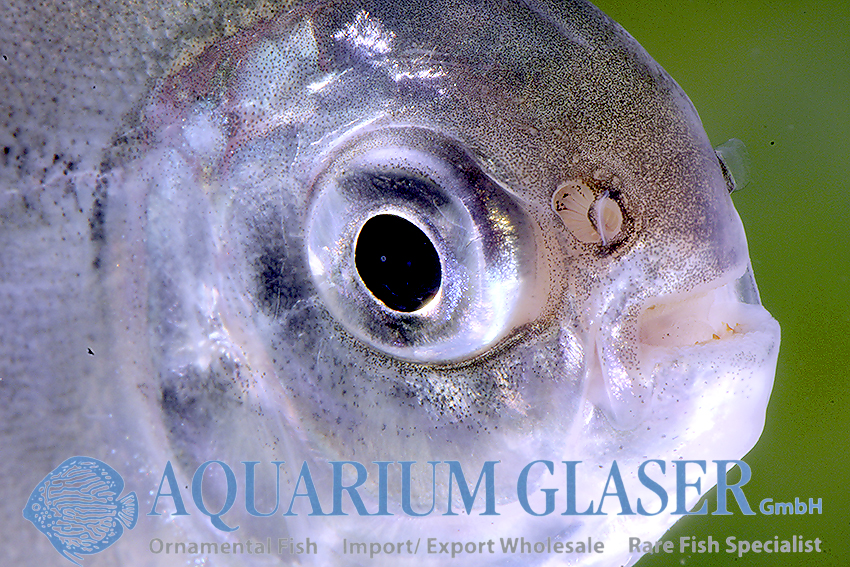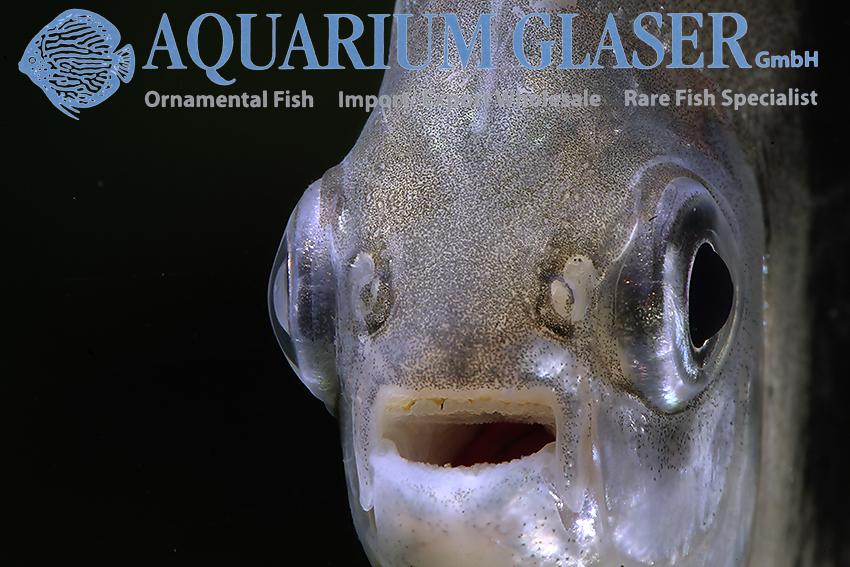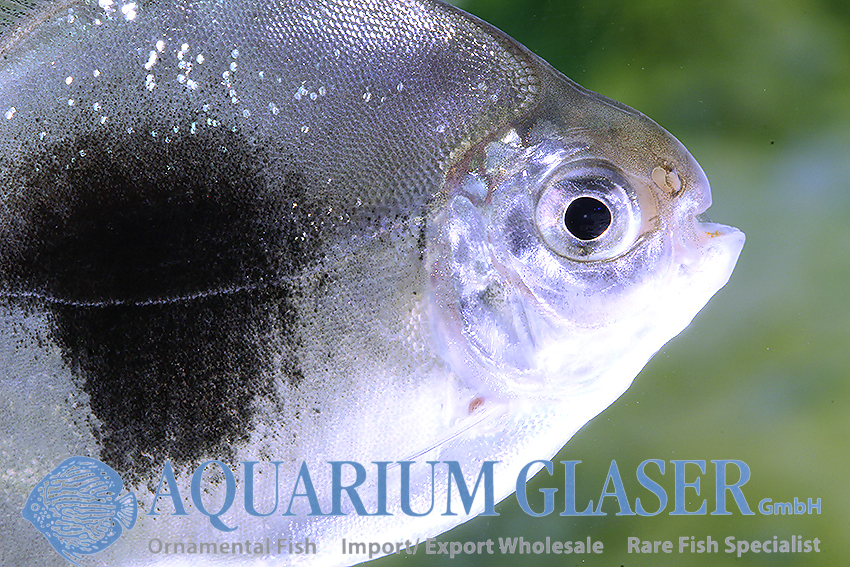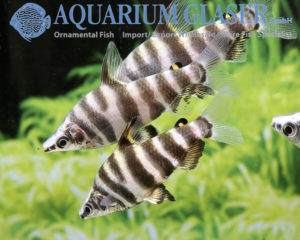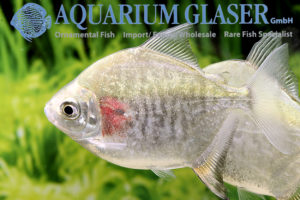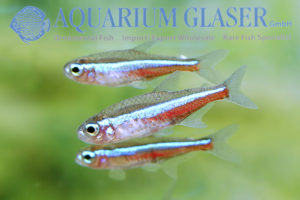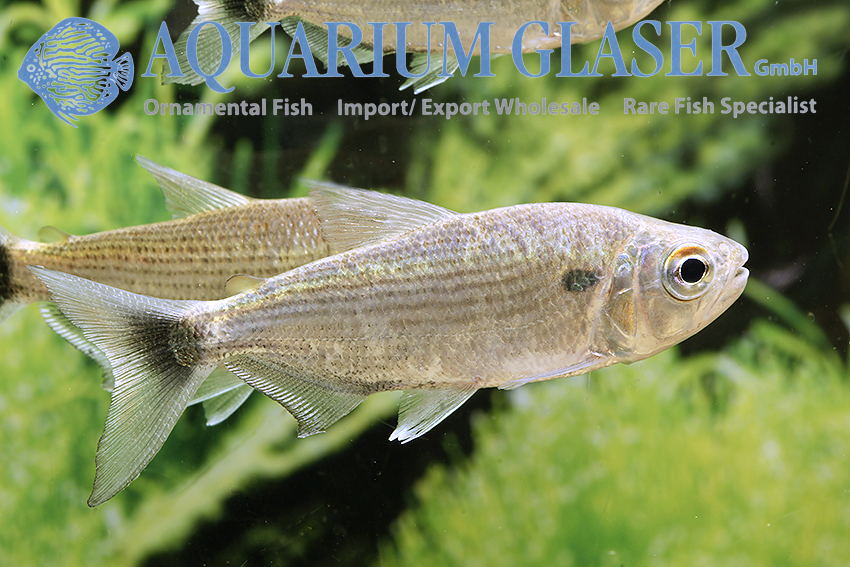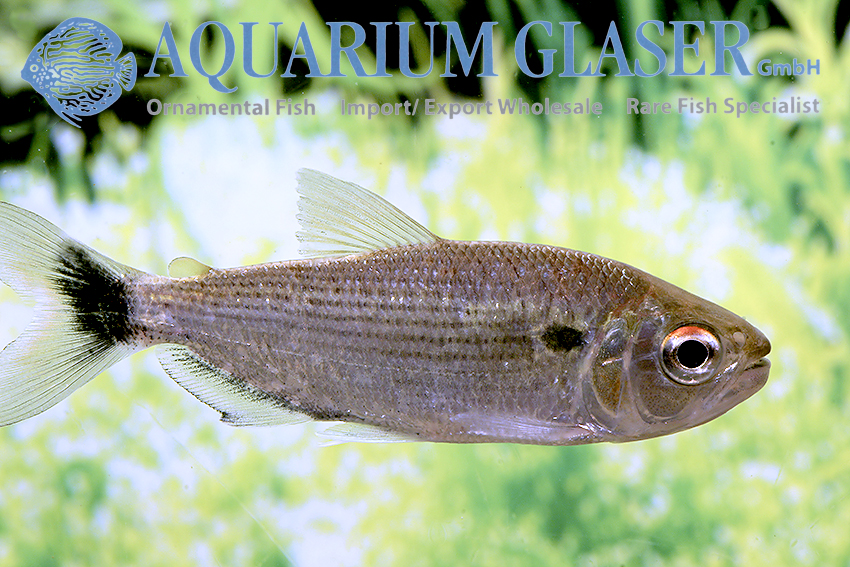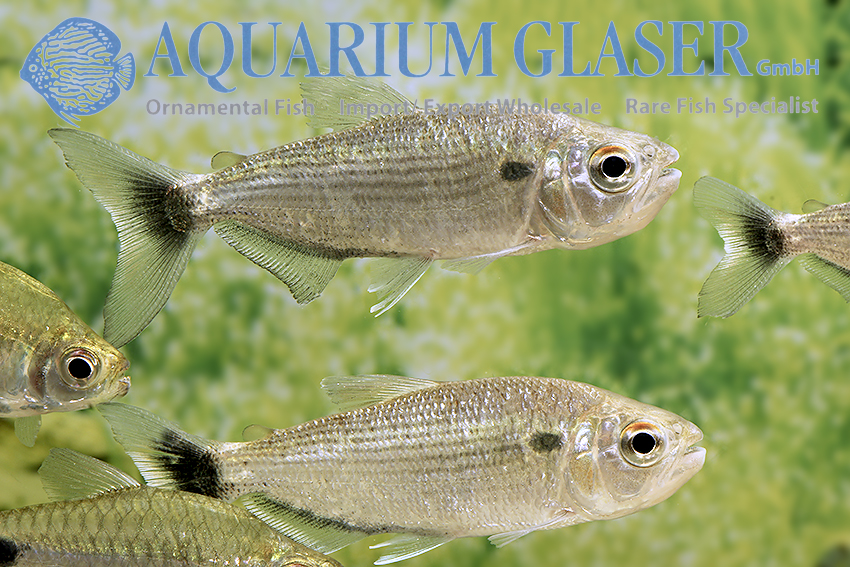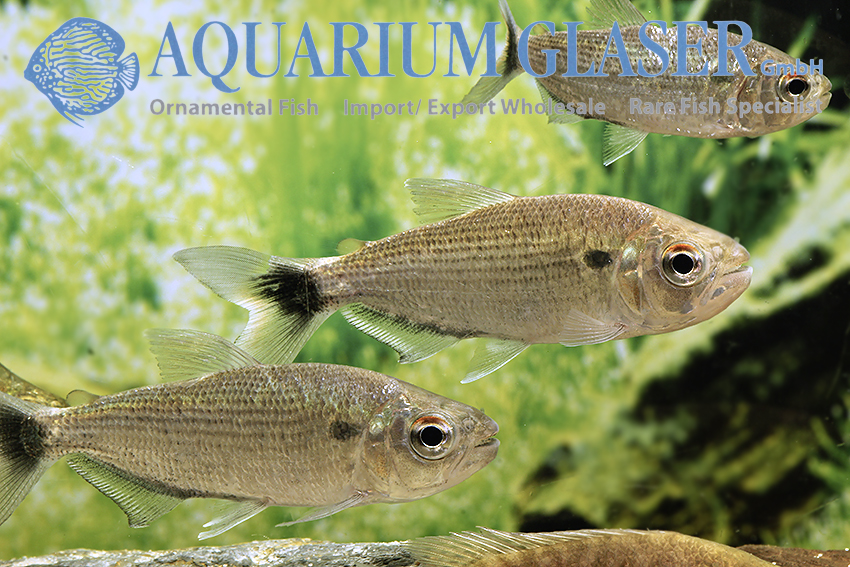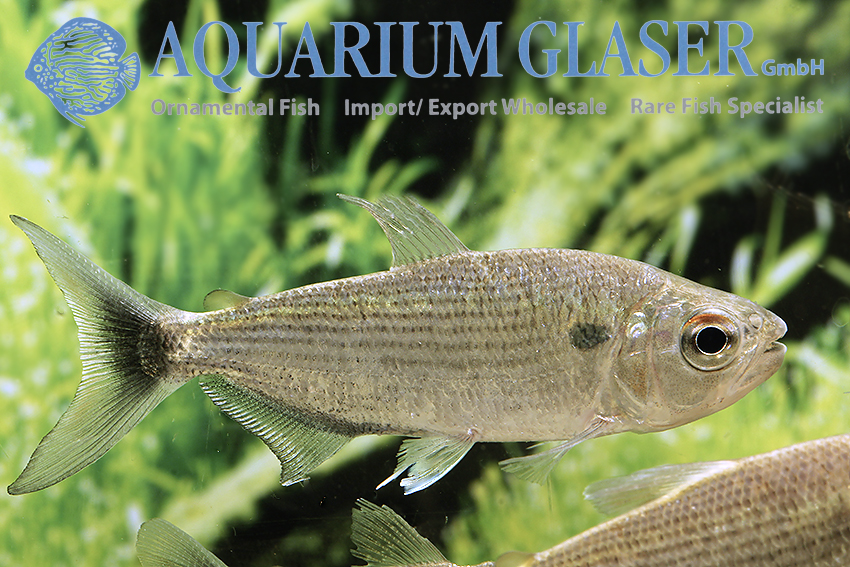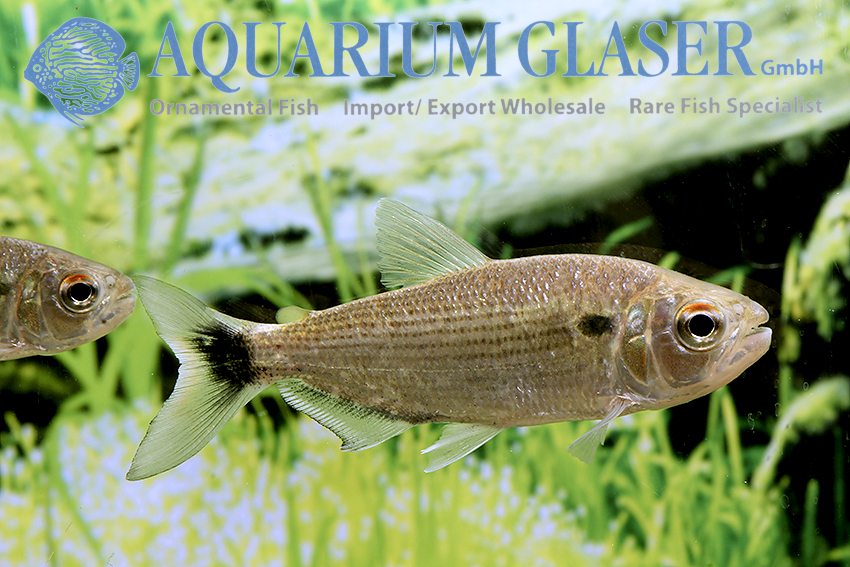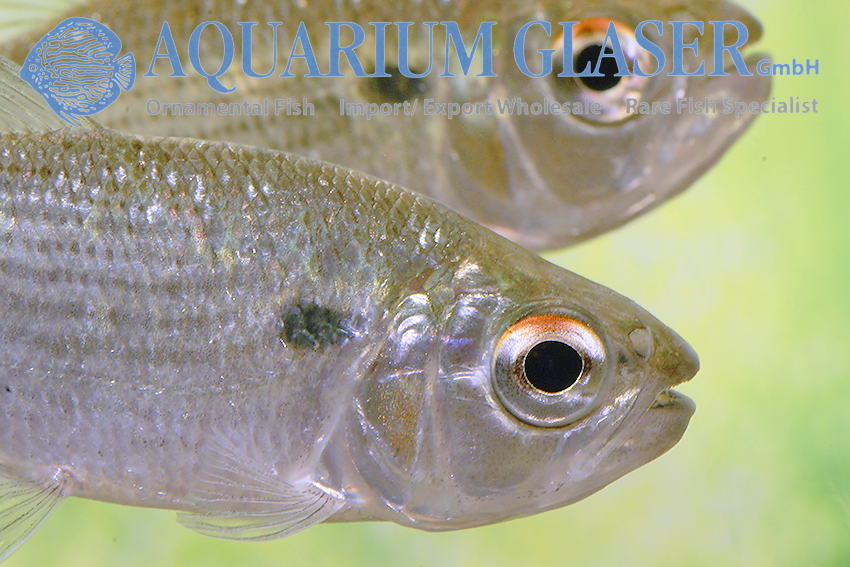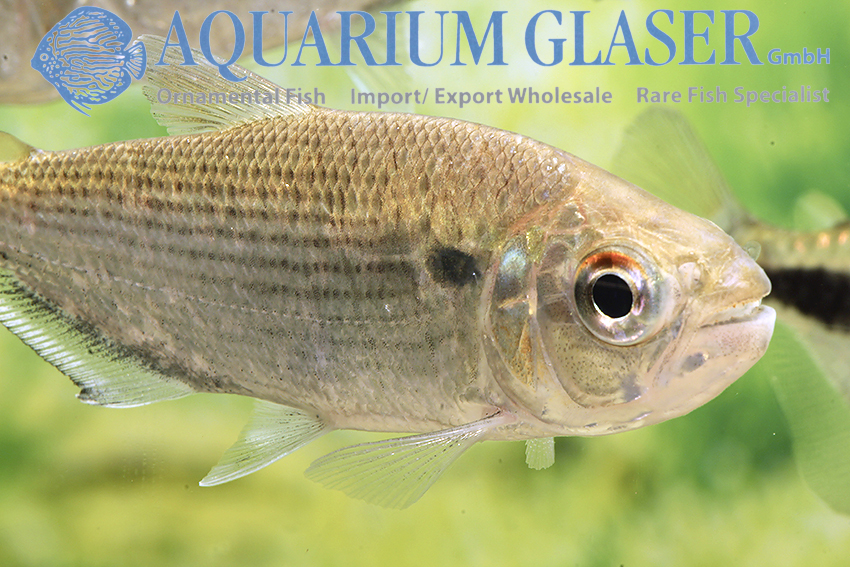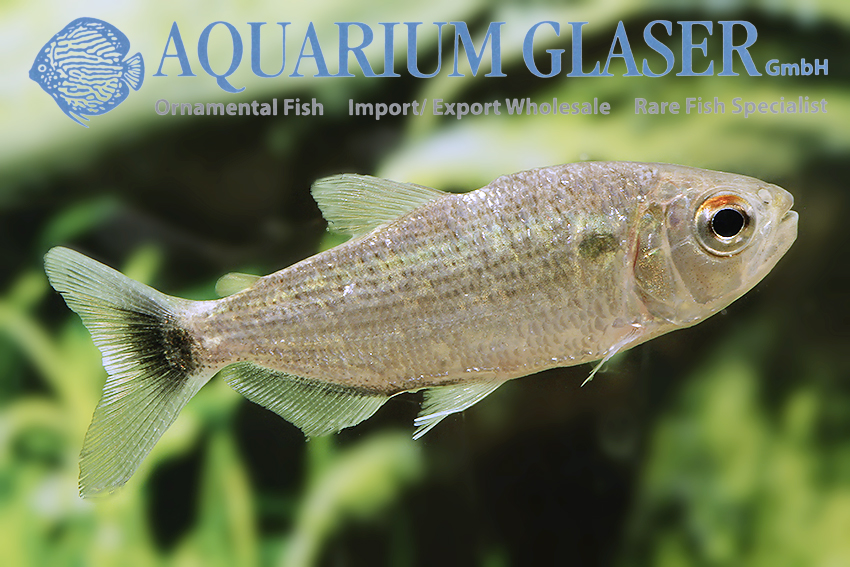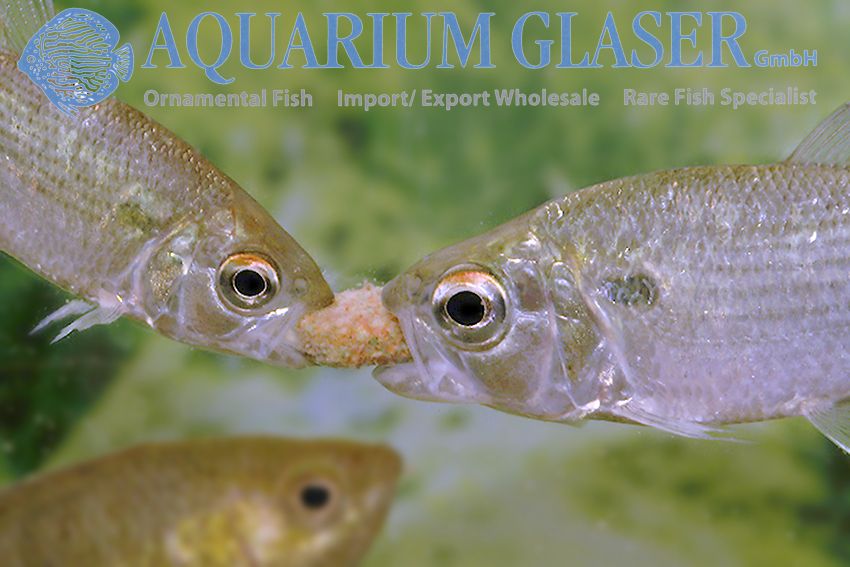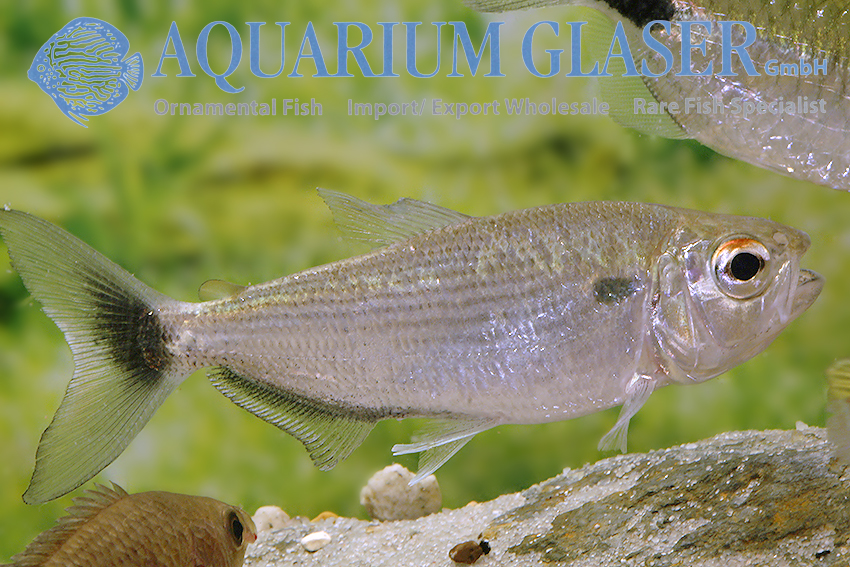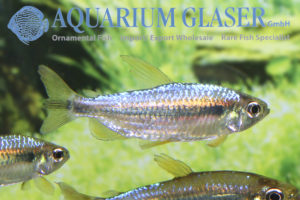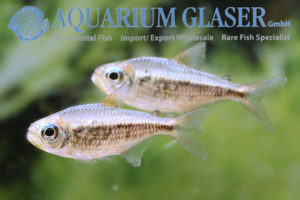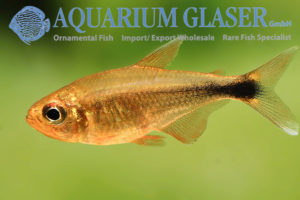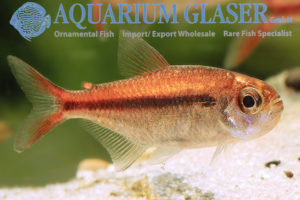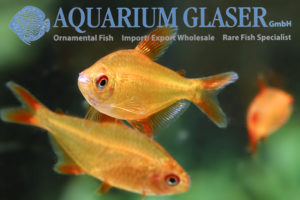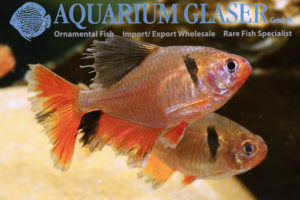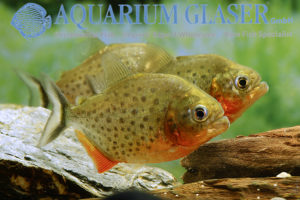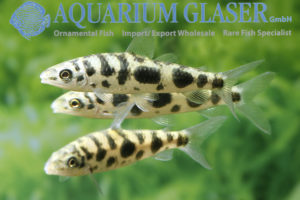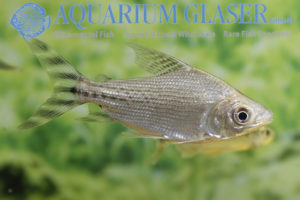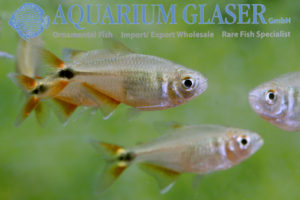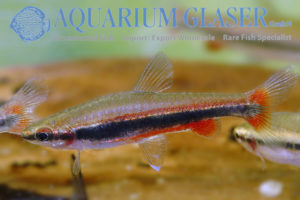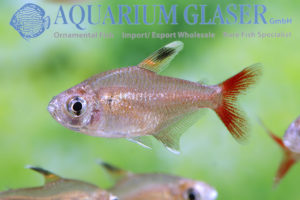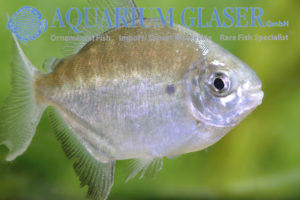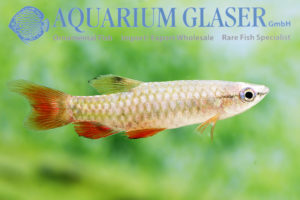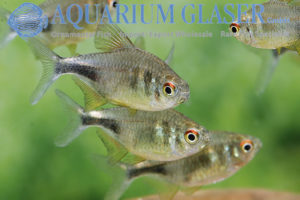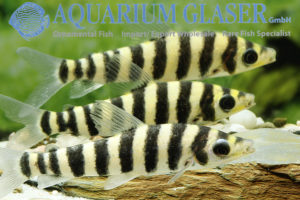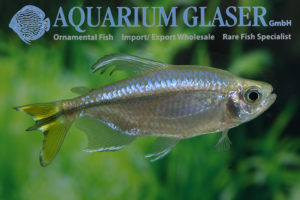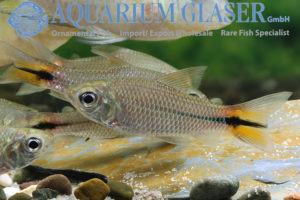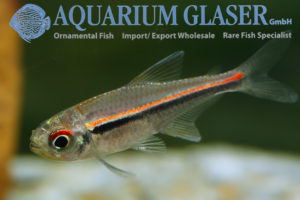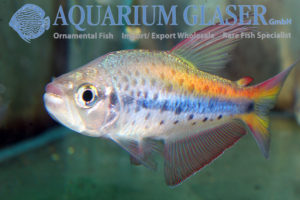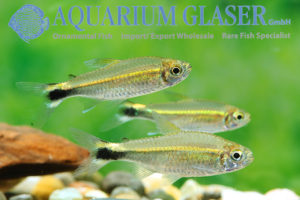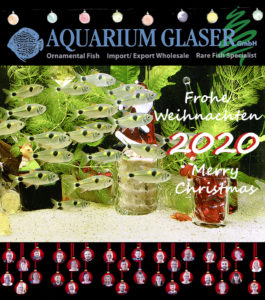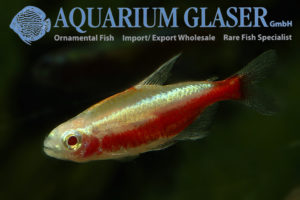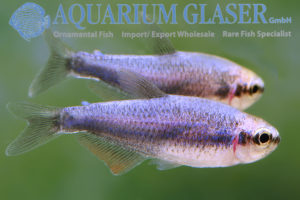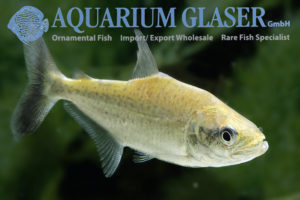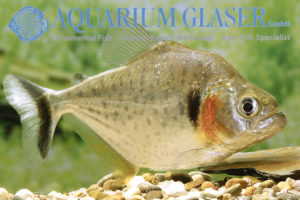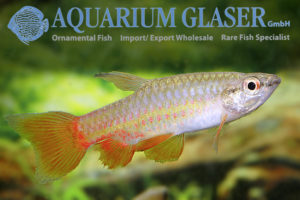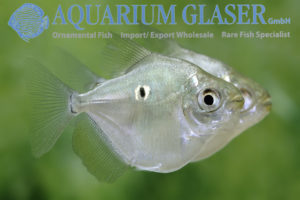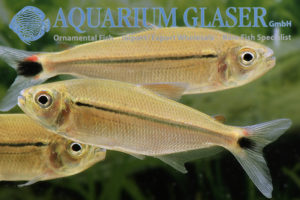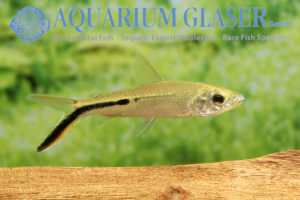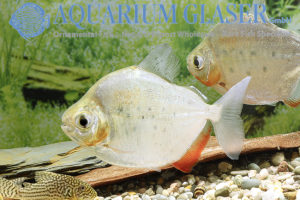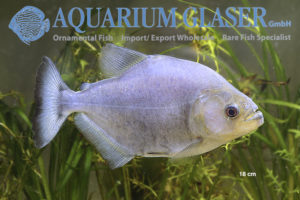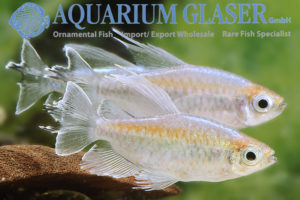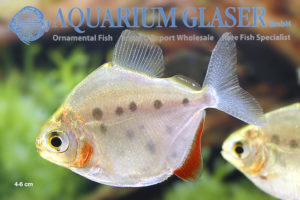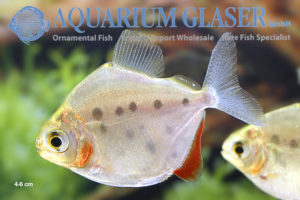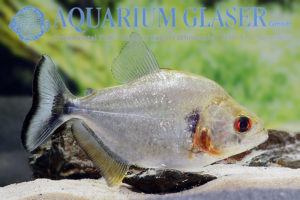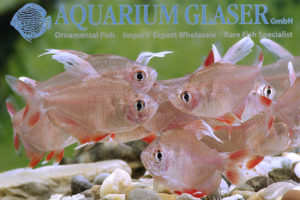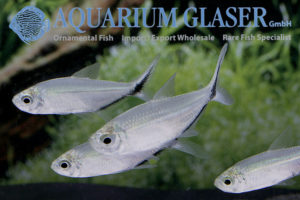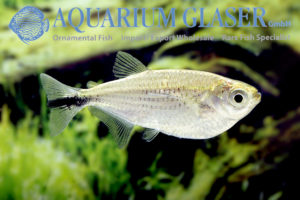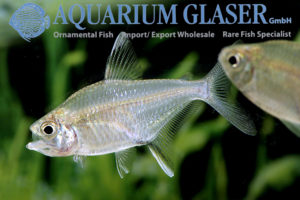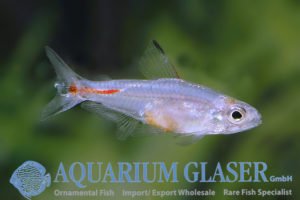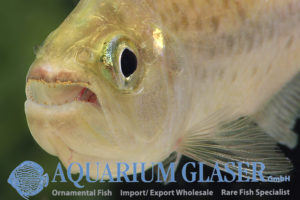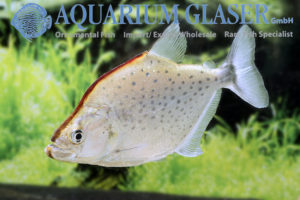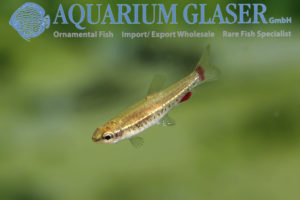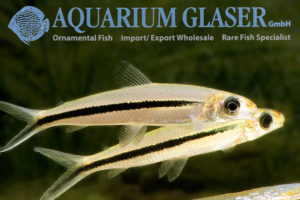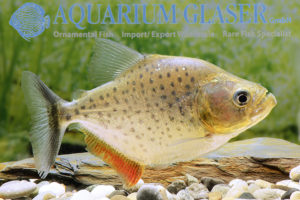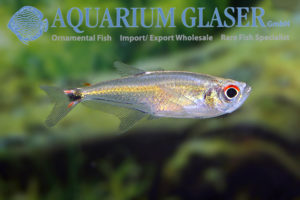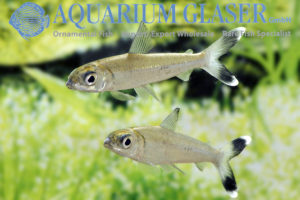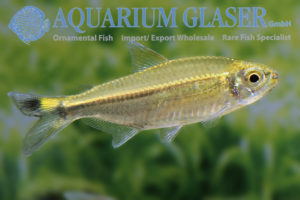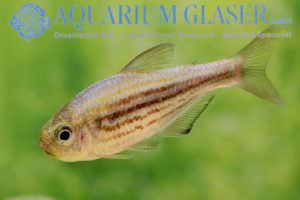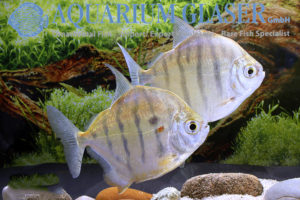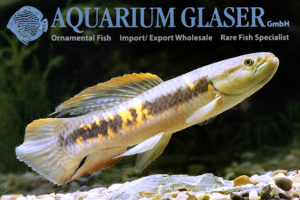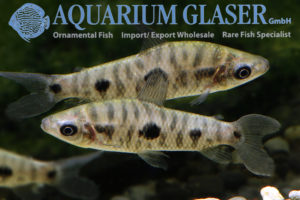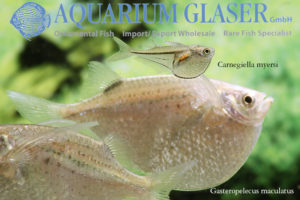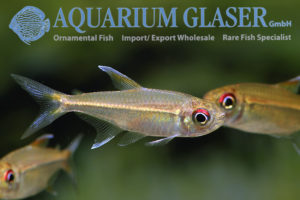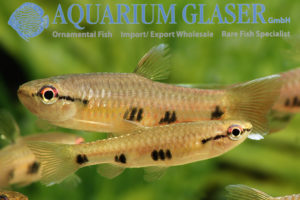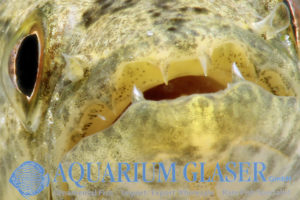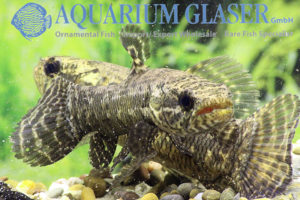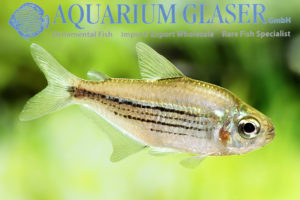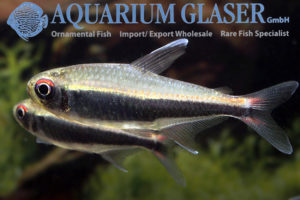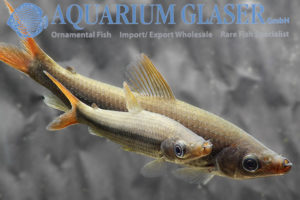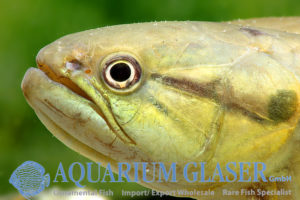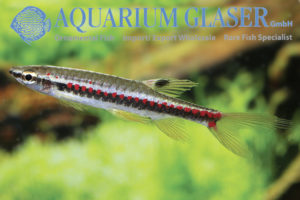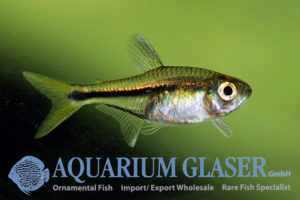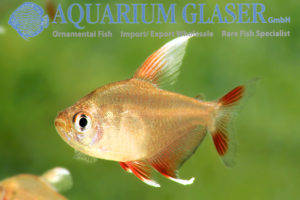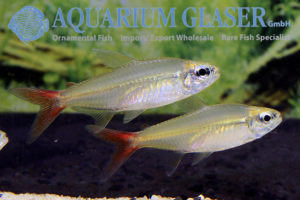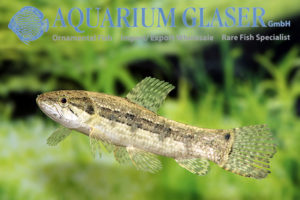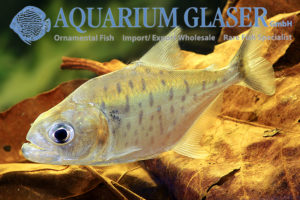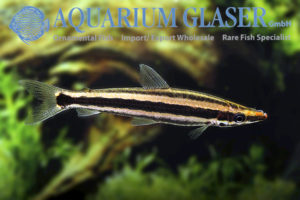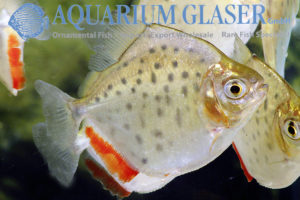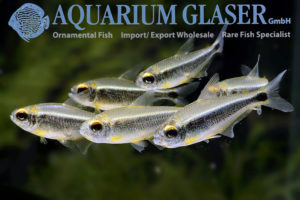For the first time we can offer this interesting and attractive tetra novelty: Hyphessobrycon sp. aff. bifasciatus “Ghost”. The origin of this fish is not known to us. Our breeder received the parents from Vienna. When the young fish obtained with them developed strong red fins, which they lost again when growing up, the close […]
09. Characoids: tetra relationship (488)
-
-
Tyttocharax cochui
Finally we were able to import once more one of the most charming dwarf tetras at all: Tyttocharax cochui. These very lively and absolutely peaceful blue flashes become only 1.5-2 cm long. The story how T. cochui was discovered is quite interesting.They were imported for the first time in April 1949 to Germany – as […]
-
Triportheus rotundatus
The strange narrow hatchetfish of the genus Triportheus belong to the flying fishes of freshwater. This is already indicated by the mighty pectoral keel with the muscles attached to it and the very long pectoral fins. The fish are predominantly silvery colored and grow to about 15 cm in length, which is why they are […]
-
Hyphessobrycon takasei
The Coffee Bean Tetra is an exceptional species within the so-called Rosy Tetras: no other species has even a hint of such a large shoulder spot. The distribution area of the species is in the lower Amazon basin, the border area between Brazil and French Guyana. There you can find the Coffee Bean Tetra in […]
-
Hyphessobrycon cyanotaenia – extra pretty wild catches
The tetra Hyphessobrycon cyanotaenia was originally imported as “Lapis-Tetra” from Brazil; that was more than 20 years ago (see https://www.aquariumglaser.de/en/?s=cyanotaenia). Since the breeding was successful this beautiful and easy to keep fish is now a common sight in the trade. The origin was mysterious for a long time, because the scientific description was based on […]
-
Hyphessobrycon procyon
One of the still very expensive tetra novelties in the aquarium is the very, very pretty Hyphessobrycon procyon from the Rio Aripuanã in the middle basin of the Rio Madeira. It looks confusingly similar to the kitty tetra, H. heliacus, at first glance. H. procyon and H. heliacus form a species complex together with the […]
-
Hyphessobrycon notidanos “Red Devil
Hyphessobrycon notidanos from the upper drainage of the Rio Tapajós in Brazil, which was scientifically described only in 2006, is apparently a quite multicolored animal. So there is the “Red Devil” with much red in the body and blue iris and the “Yellow Devil” with red iris. Both color forms are said to occur together […]
-
Gasteropelecus sternicla Albino
Hatchetfishes are normally wild caught. They are very common, easy to transport and therefore a welcome addition to the sustainable ornamental fish fishery in Venezuela, Colombia, Peru and Brazil. This is also true for the “Common” Hatchetfish, Gasteropelecus sternicla. For general information on the species, please also see https://www.aquariumglaser.de/fischarchiv/ein-grosser-klassiker-gasteropelecus-sternicla/. For some years now, offspring of […]
-
Hyphessobrycon negodagua
At present the small tetras of South America experience a new boom. Numerous species have been and are being described scientifically. Thus also the ornamental fish collectors leave their beaten tracks and look for these animals, particularly since currently peppered prices are paid for the novelties. Naturally, such a thing only works for a short […]
-
Axelrodia stigmatias
This cute dwarf tetra was described in 1913 from the Rio Madeira, where it was collected near Porto Velho. It is a typical companion fish of the two neon species Paracheirodon axelrodi and P. simulans and, as we know today, occurs throughout the range of the two neons, i.e. in the upper Orinoco and the […]
-
Hyphessobrycon melanostichos
At the moment we can offer magnificent, fully grown bred specimens of Hyphessobrycon melanostichos. Hyphessobrycon melanostichos is very eye-catching due to its bright sky-blue back coloration. The species was scientifically described in 2006 from the Brazilian state of Mato Grosso, where it occurs in the upper drainage of the Rio Tapajós. The species is distinguished […]
-
Catoprion mento
Finally we managed to import Wimple Piranhas (Catoprion mento) once again. In nature C. mento is a scale eater – at least at certain times. In terms of feeding, right now is a good time of year because there are plenty of live white mosquito larvae now, which are an ideal food for Wimple Piranhas. […]
-
Phenacogrammus cf. taeniatus
A new fashion trend in the hobby is emerging: tetras from the Congo! The region was already often in the focus of the hobby, but it was about killifishes or cichlids. The large flock of silver glittering open water species was of less interest. With the discovery of the unbelievably colorful Phenacogrammus sp. “Fantastique” (in […]
-
Copella meinkeni
These beautiful tetras were called Copella nattereri in literature for many years until a scientific study found that C. nattereri is in fact the species previously known as C. nigrofasciata and that the “C. nattereri” from the Orinoco and Rio Negro belong to a scientifically unnamed species called Copella meinkeni. We regularly offer this attractive […]
-
Nematobrycon lacortei
The Rainbow Emperor Tetra (Nematobrycon lacortei) is certainly one of the most attractive tetras in South America. Its home is in western Colombia where it is caught in the catchment area of the Rio San Juan. Males and females can be easily distinguished by the color of the iris. Already in small juveniles the males […]
-
Myloplus torquatus
From Venezuela we received very nice Myloplus torquatus. The up to approx. 25 cm long species is scientifically known for a very long time (since 1858) and in the course of time it was already assigned to the genera Myletes and Myleus. A very good recognition feature is the black fringe in the caudal fin, […]
-
Hyphessobrycon dorsalis
Tetras, which – as Hans-Georg Evers so aptly put it – are magnificently white wine colored, have a hard time in aquarists. In the dealer’s tank there is usually nothing to be seen of the discreet colors and why, many ask, should one buy colorless fish when there are so many colorful species? This opinion […]
-
Sartor respectus
From the Rio Xingu we could import the probably strangest of all headstander: Sartor respectus. Unfortunately there were only two specimens, which one of our employees acquired. Nevertheless we did not want to withhold this speciality from you, dear readers. Sartor (there are two other very similar species, one from the Rio Trombetas (S. elongatus) […]
-
Hyphessobrycon moniliger
Under the name “Hasemania hansseni” a new tetra has recently appeared on the market, which with its intense orange coloration is indeed somewhat reminiscent of the well-known copper tetra, Hasamania nana. However, one of the characteristics of the genus Hasemania is that it lacks the adipose fin that is so typical for tetras. This is […]
-
Characidium fasciatum (C. cf. pterostictum, P. sp. V)
The South American darters of the genus Characidium are unfortunately almost indeterminable. There is no current revision of the 95 described species, but additional species are constantly being described and it is known that there are still numerous scientifically unrecorded species. In aquaristics one therefore helps oneself by simply calling everything “Characidium fasciatum”, well knowing […]
-
Serrasalmus cf. gouldingi
It is indicative of the difficulties in piranha identification that this widespread species, which also occurs in an area intensively collected for the aquarium hobby (namely, the Rio Negro) was not scientifically described until 1992 and, moreover, almost never appears in the hobby. The terra typica is Anavilhanas, Río Negro, Brazil. The representatives of this […]
-
Moenkhausia phaeonota
This small (about 4 cm) species of tetra originates from upper Rio Tapajós basin the Mato Grosso state in Brazil. It is the only species of Moenkhausia with such a colour pattern. So already in the original scientific description (1979) the author mentioned that this generic placement can be only provisionally. This makeshift stands until […]
-
Acestrorhynchus cf. minimus
Unfortunately, almost all predatory fishes have one unpleasant characteristic: most of them grow too large for average aquarium dimensions. In many cases we can only keep juveniles for some time and have to part with them when it becomes nice. What a pity! An exception to this rule is Acestrorhynchus minimus, a barracuda tetra from […]
-
Apareiodon affinis
Now begins the season for one of the best algae eaters of all, the La Plata algae eater from Paraguay. Originally the species was described as Parodon affinis. It is amazingly similar in shape and coloration to the Asian Flying Foxes; but of course, the La Plata algae eater can always be easily recognized by […]
-
Abramites hypselonotus
The marbled headstander is perhaps the most unusual of all headstanders. This beautiful fish grows to about 15-20 cm in length and is hard to mistake because of its high body shape. There is only a second Abramites species, A. eques, but it has never been imported alive. It lives exclusively in the Rio Magdalena […]
-
Mylesinus paucisquamatus
A few weeks ago we introduced you to a new pacu, which we received as Tometes kranponhah. At that time we thought the animals originated from the Rio Xingu. (see https://www.aquariumglaser.de/en/fish-archives/tometes-kranponhah-2/) In the meantime, further correspondence with our supplier revealed that the animals did indeed come from the Rio Tocantins. We have received another shipment […]
-
Paracheirodon simulans
Paracheirodon simulans is the smallest and tiniest species of neon tetra. The maximum length is around 2.5 cm. One should not confuse this species with the neon costello, Hemigrammus hyanuary, which is also called the “green neon” occasionally. This is the reason why some people call Paracheirodon simulans the “blue neon”, but in the international […]
-
Alestopetersius leopoldianus
Our current Congo import contained among others the magnificent tetra Alestopetersius leopoldianus, which originates from Lac Mai Ndombe (formerly: Lake Leopold) and the middle Congo. With this maximum 9 cm long species one can get philosophical about the supposed objectivity of photography. Depending on the incidence of light the animal looks completely different! With the […]
-
Moenkhausia nigromarginata
Again we can announce a first import: Moenkhausia nigromarginata. For the first time ever we received some of these tetras described in 1994. The species reaches a length of about 5 cm. Striking are the blue eye, the blue back in incident light and the – sometimes more and sometimes less visible – zigzag bands […]
-
Hyphessobrycon moniliger
Under the name “Hasemania hansseni” a new tetra has recently appeared on the market, which with its intense orange coloration is indeed somewhat reminiscent of the well-known copper tetra, Hasemania nana. However, one of the characteristics of the genus Hasemania is that it lacks the adipose fin that is so typical for tetras. This is […]
-
Moenkhausia rubra
New legislation in Brazil now allows the import of species whose export was previously not allowed. One of these species is Moenkhausia rubra, which was only scientifically described in 2014. The species is so far known only from the Rio Juína and the Rio Juruena, both belonging to the upper Rio Tapajós drainage, Mato Grosso […]
-
Hyphessobrycon sp. “Muzel Red Cherry“
From Brazil we received this really nice novelty, which looks a bit like an enlarged edition of the Ember tetra, Hyphessobrycon amandae. However has the “Muzel Red Cherry” two (although indistinct) shoulder spots, which never occurs in H. amandae. In addition, the dorsal fin in “Muzel Red Cherry” is red with a light margin, while […]
-
Hyphessobrycon eques “Longfin”
The Serpa Tetra, also called the Callistus Tetra (Hyphessobrycon eques, formerly known as H. callistus or H. serpae), is the little man’s piranha. Just like piranhas, serpa tetras have an irresistible urge to bite the fins of other fish. And they constantly want to test out who is the stronger. This makes many exciting observations […]
-
Pygocentrus nattereri
The red-breasted shoaling piranha (Pygocentrus nattereri) is present throughout the Amazon River basin. It is the most common piranha species kept in aquariums. The breeding of these animals succeeds according to plan. Pairs are formed from a shoal, which spawn in bottom pits; the parents guard the spawning site, there is no brood care beyond […]
-
Leporinus ortomaculatus
For the first time we can offer this pretty Leporinus, which was scientifically described only in 2000. Be careful not to confuse it with L. octomaculatus, because this is a completely different species; here the confusion of one letter has consequences! So far Leporinus ortomaculatus is known from the Rio Surumu, Roraima, Brazil and from […]
-
Which Semaprochilodus comes from Indonesia?
Quite clearly – none at all! Because this genus is exclusively from South America. But in Indonesia these beautiful large tetras are bred and occasionally we import juveniles from there. Then one wonders which species it is. We get them as S. insignis and so we sell them on, but is the determination correct? This […]
-
Psalidodon anisitsi (= Hyphessobrycon a., Hemigrammus caudovittatus)
One of the oldest aquarium fishes is the Buenos Aires tetra, of which the correct scientific name was only recently determined: Psalidodon anisitsi. To most aquarists, however, the species is probably still known as Hemigrammus caudovittatus (or Hyphessobrycon anisitsi), and it is under this name that it is found in most aquarium books. Since its […]
-
Nannostomus beckfordi
Nannostomus, also known as pencil fish, propel through the aquarium like small, colorful zeppelins. The unusual, somewhat stiff-looking swimming style makes them unique in the colorful world of tetras. There are quite a few species of Nannostomus-species, but the Red Pencilfish (Nannostomus beckfordi), which grows up to 6.5 cm long (but appears smaller due to […]
-
Hyphessobrycon micropterus
In 1915 the scientist Carl Eigenmann described a new tetra genus, which he named Megalamphodus. Type species is M. megalopterus, an aquaristic very well known species: the Black Phantom Tetra. In 1997 Megalamphodus became a synonym of Hyphessobrycon. Of the remaining species assigned to Megalamphodus in 1915 (ecuadoriensis, eques, heteresthes, melanotus, micropterus), only the Serpae […]
-
Tometes kranponhah
In the meantime it has turned out that these animals are Mylesinus paucisquamatus from the Rio Tocantins and the statement that they came from the Rio Xingu was a mistake. New species of large fish are still being found in the rivers of South America, despite they have been well studied. This is mainly due […]
-
Pyrrhulina brevis
We could import the beautiful species Pyrrhulina brevis already several times from Peru (see https://www.aquariumglaser.de/en/fish-archives/pyrrhulina-brevis-2/). This time they have a very intensive pattern in the anal fin, which reminds of an eye spot and corresponds with a similar pattern in the caudal fin. They are magnificent fish! For our customers: the animals have code 286754 […]
-
Hemigrammus pulcher
From the upper Amazon in Peru comes the beautiful garnet tetra, which grows 3-4 cm long. The very peaceful animal actually has characteristics like a carbuncle, a gemstone, which in fairy tales has the ability to make the owner invisible: because the eye and tail root of Hemigrammus pulcher shimmer like gemstones, but the individual […]
-
Leporinus fasciatus
The tetras of the genus Leporinus (the genus name is a derivative of the Latin word “lepus” for “hare”) belong to the characteristic river fishes of South America. They owe their name to the shape of their mouth in combination with the elongated “hare teeth” in the lower jaw of some species, which reminded the […]
-
Alestopetersius caudalis
The Yellow Congo Tetra (Alestopetersius caudalis) originates, as the name suggests, from the Congo. However, it is almost never traded as wild catch, because it can be bred very well. With a final length of about 6 cm it belongs to the smaller species of the Congo tetra relationship. In the course of its aquaristic […]
-
Curimatopsis macrolepis
The genus Curimatopsis comprised five described species until 2009 – now (2021) there are more than twice as many, namely 11! Curimatopsis can be divided into two major groups. First the C. macrolepis group with 6 species and second the C. evelynae group with 5 species. The best distinguishing feature of the two groups is […]
-
Hyphessobrycon heterorhabdus
Already in 1894 the three-banded flag tetra (Hyphessobrycon heterorhabdus) was described scientifically; the animals on which the description was based came from the Brazilian state of Pará, more detailed information or illustrations are not available. From 1910 and in the 1920s, when the tetras advanced to the most popular aquarium fishes, also three-banded tetras came […]
-
Pseudochalceus kyburzi
In our last post on this impressive and beautiful tetra species from Colombia, we wrote “This tetra usually grows to around 5 cm long, with 8 cm given as the maximum size.” (https://www.aquariumglaser.de/en/fish-archives/pseudochalceus-kyburzi-4/). Since last week we know, this maximum size can actually be reached! Wow, that’s the first thing we thought of these huge […]
-
Hemigrammus hyanuary Wild
In 1957, when the first Green Tetras or Neon Costello (Hemigrammus hyanuary) were imported, the tetras were absolute fashion fish. Otherwise the comparison with the neon or cardinal tetra can hardly be explained, because H. hyanuary – which by the way is named after Lake Hyanuary in Brazil – is really nicely colored, but it […]
-
Exodon paradoxus
For many aquaristis the Bucktooth tetra, Exodon paradoxus, is simply the most beautiful tetra from South America. The splendid fish glitter and glimmer like diamonds and they never stay still. They hunt and hit their conspecifics permanently and an uneducated watcher may become quite concerned that the fish will eventually hurt each other. But this […]
-
Paracheirodon axelrodi “Gold”
The cardinal tetra, Paracheirodon axelrodi, is one of the most traded ornamental fish worldwide. It is a big exception in the ornamental fish trade, because it was mainly traded as a wild catch; it is different with almost all other important ornamental fishes, which are mainly or exclusively traded as bred ones. It is said […]
-
Inpaichthys kerri “Super Blue”
There is a nice story about the discovery of the king tetra, which we don’t know if it’s true, but it’s worth telling: In the Instituto Nacional de Pesquisas da Amazônia (INPA), Manaus, Brazil, aquatic plants were kept in an aquarium. Fish were actually not in it. But suddenly, as if from nowhere, cute baby […]
-
Serrasalmus elongatus
This very elongated Piranha can be confused hardly with other species because of its characteristic body shape. Type locality is the Rio Guaporé, Mato Grosso, Brazil. Aquaristic imports are mostly from Peru. Serrasalmus pingke from Venezuela was described from the Rio Apure. The holotype (54 mm long) is shown in MACHADO-ALLISON (2002); it has a […]
-
Serrasalmus humeralis
The identification of many Piranha species is difficult. One of the earliest described piranha species and therefore with many taxonomic problems is Serrasalmus humeralis. Valenciennes was the first descriptor in 1850, but there is no question that he had received the type specimen, for which he states “Amazon” as the type locality, from Castelnau. In […]
-
Pyrrhulina brevis
The characins of the genus Pyrrhulina can be better compared to cichlids than to other characins in terms of their behavior. The males occupy small territories in the breeding season, color themselves splendidly and defend the spawn energetically until the young hatch. The generic name Pyrrhulina means “small bullfinch” because the males of many species […]
-
Mylossoma aureum
The magnificent pacus of the genus Mylossoma that reach at most approximately 30 cm of length (the average length in the nature amounts to approximately half of this measure), are only with difficulty determinable. The last revision from 2018 (Mateussi et al.) distinguishes 4 species south of the Andes (another species, M. acanthogaster, occurs in […]
-
Jupiaba sp. „Cherry Spot“
Once more we were able to import a new species of tetra from Venezuela which does not resemble to any species known to us. According to the supplier the animals were collected in small brooks in the surroundings of Puerto Inirida. There are no doubts that our new imports belong to the Astyanax relationship in […]
-
Anodus orinocensis
From Venezuela we could import Anodus orinocensis for the first time. As a young fish A. orinocensis often lives in mixed shoals with Hemiodus gracilis. The two species really look amazingly similar, but Anodus is a Aufwuchs eater, and also filters the water for small organisms and swims mostly in “normal” horizontal swimming position, while […]
-
Metynnis lippincottianus
Silver Dollars, which are the piranha relatives that eat mainly vegetable food, usually grow quite large, most species grow to over 20 cm, some to 40-60 cm long. The smallest known species is Metynnis lippincottianus, of which we can offer sexually mature specimens. They are currently 8-12 cm long, more than 15 cm total length […]
-
Serrasalmus immaculatus
In great parts of South America there are large (up to 50 cm) piranhas, which usually become black when they are old. Another common feature of these piranhas is a red iris. It is currently common practice to refer to all these animals as Serrasalmus rhombeus because they are indistinguishable as adult fish. However, young […]
-
Phenacogrammus interruptus
The Congo Tetra, Phenacogrammus interruptus, sometimes also called the Blue Congo Tetra, is the only one of the approximately 350 tetra species in Africa that is always available in pet shops. This is of course due to its beautiful colouring, which shimmers differently on the flanks depending on the incidence of light, the reddish-brown back, […]
-
Metynnis sp. Big Spots Peru
From Peru we occasionally receive beautiful young Metynnis. We have not yet been able to identify them; they either belong to a scientifically undescribed species or represent a local form of M. maculatus. They certainly belong to the species cluster around Metynnis maculatus and we think that the final size, similar to M. maculatus, is […]
-
Metynnis sp. Big Spots Peru
From Peru we occasionally receive beautiful young Metynnis. We have not yet been able to identify them; they either belong to a scientifically undescribed species or represent a local form of M. maculatus. They certainly belong to the species cluster around Metynnis maculatus and we think that the final size, similar to M. maculatus, is […]
-
Serrasalmus rhombeus „Tocantins“
From the Rio Tocantins in Brazil we received wonderful, 11-14 cm long Serrasalmus rhombeus. This species grows 35 cm, maybe even 50 cm long, making it one of the largest piranha species of all. One can recognize adolescent S. rhombeus quite well by the combination of ruby red eye, a shoulder spot which is not […]
-
Hyphessobrycon “ornatus White Fin” XL
We just have a tank full of fully grown rosy tetra (Hyphessobrycon rosaceus) of the breeding form “White Fin” in stock. These magnificent fish are a real feast for the eyes. Read more about this form of fish, which is also known as H. bentosi or H. ornatus in the hobby here: https://www.aquariumglaser.de/en/fish-archives/hyphessobrycon-ornatus-white-fin-2/ For our […]
-
Moenkhausia costae
This tetra originates from Brazil (Rio Sao Francisco and Itapicuru). It reaches a maximum length of about 7 cm. Currently we can offer German bred specimens of this attractive schooling fish. For our customers: the fish have code 268613 on our stocklist. Please note that we exclusively supply the wholesale trade. Text & photos: Frank […]
-
Triportheus cf. nematurus
The unusual genus Triportheus contains very interesting, somewhat larger species. Depending on the species these fish attain a length of 15-25 cm. Currently 16 species are distinguished that inhabit all major river systems of South America. From time to time we import members of the genus from Paraguay. Two species can be found there, namely […]
-
Moenkhausia hemigrammoides
From Venezuela we recently received „feather tetras“. This is what we used to call tetras that have a striking black stripe in the anal fin, accompanied by a white line in front of it. In general, however, the term “feather tetra” is alternatively used to species of the genus Hemiodus or Hyphessobrycon copelandi. Our “feather […]
-
Brittanichthys axelrodi
From the catchment area of the Rio Negro these interesting, rarely traded characins reached us. Brittanichthys axelrodi is a true black water fish, which should be kept at pH 4.5 – 6 and low hardness. Filtering via peat can be very helpful here. In addition to improving the chemical parameters, the bactericidal effect of peat […]
-
Pseudochalceus kyburzi
After several years we finally were able again to import this very beautiful tetra from Colombia once more. This species attains usually a length of about 5 cm, the largest one reported had about 8 cm in length. In respect of the general look and the behaviour Pseudochalceus kyburzi can be best compared with the […]
-
Serrasalmus geryi
If ichthyologists were superstitious, they would surely believe that Serrasalmus geryi was sent to them so that they would not despair. No other species of piranha can be identified at all stages of its life as reliably and unequivocally as this endemic (i.e. it occurs exclusively there) of the Rio Tocantins in Brazil. The reddish-brown […]
-
Nannostomus anduzei
Finally we could import one of the smallest fish species of the Amazon basin again: Nannostomus anduzei. They stay – including the tail fin – usually smaller than 2 cm. Our current import came via Manaus, so they are Brazilian animals; the specimens on which the original description was based came from the department Amazonas […]
-
Hemiodus thayeria
Shortly after the first import of Argonectes longiceps we were able to import another feather tetra, which has not yet been seen, at least by us: Hemiodus thayeria. This beautiful, elegant fish comes from the border area of Brazil and Colombia at the Rio Negro. The type specimen was already collected in 1925 by Carl […]
-
Serrasalmus cf. sanchezi “Pará”
When trying to identify piranhas, one often pokes in the dark. The differences between juvenile and adult forms are dramatic, both in terms of physical and color characteristics. Over the decades that we have imported young piranhas from all parts of South America, some characteristics have proved to be quite reliable in combination: 1- is […]
-
Gnathocharax steindachneri
In the natural habitat of the cardinal tetra food sources are very scarce. So it is really astonishing how many species can exist there. However, many of them stay very small. Good luck for the aquarium hobby, for they all make very good ornamental species! Even a predatory species of that biotope is such a […]
-
Argonectes longiceps
We could import a quite unusual tetra for the first time in some specimens from Colombia: Argonectes longiceps. Although the species is inconspicuously colored, it looks quite attractive with its black and white tail fin pattern. They are peaceful animals which, in contrast to the closely related Hemiodus species, have a normal, i.e. horizontal swimming […]
-
Moenkhausia celibela
For over 150 years a small tetra is known in science, that is placed due to the scaltion of the tail fin at present into the genus Moenkhausia, under the name M. lepidura. The species differs from all other Moenkhausia species, it was thought, by the coloration of the tail fin, in the upper half […]
-
Hyphessobrycon hexastichos
This pretty tetra is a double of the very similarly colored species Moenkhausia agnesae. It remains however with 5,5 cm length smaller than M. agnesae, which becomes nearly 7 cm long. In addition, H. hexastichos, which occurs exclusively in the upper catchment area of the Rio Tapajós in Brazil, is not as quarrelsome as M. […]
-
Metynnis fasciatus
This beautiful fish, a serrasalmid and thus a relative of piranhas a pacus, is still enigmatic for scientists. The species Metynnis fasciatus has been described on the basis of a young fish from Brazil (Rio Capiru). The type specimen is regarded as lost. The species is identical with M. hypsauchen in all respects exept the […]
-
Erythrinus erythrinus PERU
According to the current state of science, the predatory tetra species Erythrinus erythrinus is widespread throughout practically all of South America: Argentina, Brazil, Ecuador, Peru, Colombia, Paraguay, Bolivia, French Guiana, Guyana, Suriname, Trinidad and Tobago and Venezuela. However, they look somewhat different everywhere, so that one must assume that in case of a modern revision […]
-
Leporinus friderici
One of the longest known Leporinus species is L. friderici. It was already described in 1794 under the name Salmo friderici. The author, Marcus Eliser Bloch, writes: “This fish is a resident of Surinam’s waters. I received it from the present governor, the Lord of Friderici, along with several other fish. He has an excellent […]
-
Thoracocharax stellatus, Gasteropelecus maculatus JUMBO, Carnegiella myersi, Carnegiella strigata
The platinum hatchetfish, Thoracocharax stellatus, is regarded as biggest species of the hatchetfish. In the scientific literature, up to 6.8 cm of standard length (without tail fin) are indicated for the species. However, much smaller animals are always imported. The specimens that we currently offer as “large” have a standard length of about 3.5-4 cm. […]
-
Hemigrammus cf. bellottii “Venezuela”
One of the most common tetras from the Amazon and Orinoco is Hemigrammus bellottii. The species is easily recognizable by the golden longitudinal stripe and the red eye; other pattern elements (tail spot, fin coloration etc.) are usually missing. Only a shoulder spot can be present from time to time – depending on the mood. […]
-
Pyrrhulina spilota
The tetras belonging to the genus Pyrrhulina combine the advantages of two basic groups of ornamental fish. The first group are the schooling species that are always visible and swim merely in the open water: tetras and barbs. The second group has a fascinating behaviour and takes care for the brood: the cichlids and the […]
-
Hoplias malabaricus “Venezuela”
We have already mentioned it: currently we have three species of the genus Hoplias from Venezuela in our stock. The common wolf tetra (Hoplias malabaricus) has a huge distribution area, but it is very likely that this “species” proves to be a species complex consisting of several, at least partially undescribed species. With the “Hoplias […]
-
Hoplias curupira
Right now we have three Hoplias species from Venezuela in our stock. Hoplias curupira belongs to the real rarities and is accordingly sought after among predatory fish fans. With a final length of about 40 cm the stocky species remains relatively small. It belongs within the genus Hoplias to the so-called H.-lacerdae group, which besides […]
-
Moenkhausia simulata
We obtained a somewhat irritating import of a very rare species of tetra last week from Peru. In all probability, it is Moenkhausia simulata; however, our new import differs slightly from the previously known M. simulata in coloration. All other tetra species with a pattern of several horizontal stripes (Astyanax lineatus, A. kullanderi, A. superbus, […]
-
Hyphessobrycon peruvianus
Three species of tetra in northern South America are obviously close relatives to each other and often confused: Hyphessobrycon loretoensis from Peru, H. metae from Colombia, and H. peruvianus, again from Peru. From these, H. loretoensis has been portayed here: http://www.aquariumglaser.de/en/hyphessobrycon-loretoensis_de_1188.html. Currently we were able to import the second Peruvian species once more, H. peruvianus, […]
-
Pseudanos winterbottomi
In the past years we received this rare headstander, scientifically described only in 2005, which is known from the Orinoco in Venezuela and the Tapajós in Brazil, only very occasionally as a by-catch from Venezuela. Mostly the animals were found among Anostomus ternetzi or Pseudanos trimaculatus. Now we could finally import some specimens of this […]
-
Hoplerythrinus unitaeniatus “Orinoco”
From Colombia we received an import of the striped wolf tetra, Hoplerythrinus unitaeniatus. The systematics of these almost over the entire South America spread fish is poorly understood. Only the one species, H. unitaeniatus, is recognized commonly, but there are a lot of synonyms, among them the (without justification) occasionally recognized species H. cinereus (Trinidad […]
-
Copella nattereri
It took until the year 2006 that the tetra specialists Axel Zarske and Jaques Géry found out that the species described as Copella nattereri was practically not present in the hobby and that the red spotted Copella, which was named C. nattereri until then, was not known to science yet! So Zarske and Géry described […]
-
A new little tetra from Peru
We admit it: when we unpacked the animals, we were just disappointed. Colourless tetras, obviously young, with a black longitudinal line. Quite great. Because of the round head form they reminded of the genus Bryconamericus, a very species-rich and difficult to overview genus, and because we had to book them somehow into the system, from […]
-
Hyphessobrycon “ornatus White Fin”
Among he longest-serving rosy tetras in the hobby is Hyphessobrycon ornatus, even if the species has a true odyssey concerning the naming behind it and is called Hyphessobrycon rosaceus according to the latest state of affairs; before it was equated with H. bentosi. The first specimens arrived already in 1933 from Guyana. Breeding was not […]
-
Moenkhausia copei
From Venezuela we received a very nice color variation of Moenkhausia copei. The fish now look a bit like a stretched version of Moenkhausia collettii, where the shoulder spot so typical for M. collettii is missing and where the orange tail fin of M. collettii is red. We were able to import Moenkhausia copei for […]
-
Hoplias malabaricus German bred
For the first time we can offer this predatory tetra as German bred ones! Hoplias malabaricus is one of the most widespread species of tetra in South America; it is therefore suspected that it is more likely to be a number of externally very similar, so-called cryptic species. The offspring was bred with a pair […]
-
Serrasalmus manueli
This piranha, described from Venezuela, is easily recognizable by its characteristic pattern in connection with the head profile, but still causes great confusion, as the fish in the trade come from completely different areas and are still indistinguishable. S. manueli was described as Pygocentrus manueli from the Río Paraguaza, middle Orinoco, Venezuela. The first description […]
-
Anostomus ternetzi
The golden striped headstander, Anostomus tenetzi, has a very wide distribution in South America. It is recorded from Brazil, French Guyana, Guyana, Suriname, and Venezuela. The specimens on which the original descritption based, originated from Venezuela, and we were able to import them from there once more. This beautiful fish is among the most peaceful […]
-
Metynnis maculatus
There are two rather similar species of the silver dollar genus Metynnis with a pattern of black spots. They differ mainly by the (externally not visible) number of the gill rakes and the number of scales along the long side of the body, but also somewhat in relation to the body shape. We currently call […]
-
Moenkhausia heikoi
For the first time we could import, even if only in very limited numbers, this tetra from the Rio Xingu described only in 2004. The animal became known in 2001, when Rainer Stawikowski presented the fish as “Hemigrammus sp. Xingu” in the journal DATZ. The scientific description took place in 2004, twice and almost simultaneously: […]
Myloplus (formerly: Myleus) “Lamax III”
Silver dollars and Pacus are magnificent fish. However, they grow quite large and most species eat plants, so they are mainly suitable for show aquariums and specialists, less for the classic community tank. Therefore, the demand can usually be met well with wild catches. However, some time ago breeders in Asia have taken up the species Myloplus schomburgkii (formerly the species was placed in the genus Myleus) to be independent from the irregular supplies from South America.
Myloplus schomburgkii is widespread and common in the middle and lower Amazon, the Rio Nanay, and the upper Orinoco. The species reaches a maximum length of about 45 cm and is used as a food fish. Juveniles show a crescent-shaped banding on a silvery ground, which varies in width depending on origin, so it is reasonable to assume that future studies will show that there are multiple, closely related species. The anal fin is colored red.
How and when the breeding form “Lamax III” appeared for the first time is not documented, we probably showed the first pictures in the western press, that was in 2012. It seems to be a very rare form, which is difficult to manifest in breeding, because on the world market in 2012 only 30 animals were offered, of which 20 came to Aquarium Glaser. One can probably say without exaggeration that at that time Myloplus “Lamax III” was one of the rarest fish in the world. In the meantime this has been put into perspective and you can get the form from several Asian breeders for more moderate (but still high) prices.
It is a bit speculative to assign Lamax III to the species Myloplus schomburgkii, but the thesis seems credible, since the breeder from which the fish originally came offered “normal” M. schomburgkii as “Lamax I” and the naturally occurring variant or species with the broad central band from the Alto Solimoes as “Lamax II”. Thus, it is reasonable to think that “Lamax III” is a mutation that occurred during the breeding of the aforementioned two forms. On the other hand, it is most likely not a cross, because all 20 “Lamax III” from the import of 2012 and also the now (2021) imported animals look identical. Moreover, in case of a hybrid there would certainly be more specimens, since such large fish as M. schomburgkii spawn several tens of thousands of eggs at once. The Lamax III are internationally also called “Blackberry”.
For our customers: the fish have code 270904 on our stocklist. Please note that we only supply wholesale.
Text & photos: Frank Schäfer
Brycon amazonicus Colombia
The species of the genus Brycon belong to the large tetras of the open water. 21 species east of the Andes were distinguished in the last revision by Flávio C. T. Lima (there are others west of the Andes). Their identification, especially of juveniles, presents considerable difficulties, because they usually grow to 30-40 cm in length and adults look quite different from juveniles. That is why we listed B. amazonicus as Brycon sp. Colombia on our stocklist until now. However, the fine line pattern of the juveniles, which is very unusual for Brycon species, and the distinctive caudal fin pattern now lead us to believe that these animals are the species B. amazonicus, which is widely distributed in the Amazon and Orinoco systems.
The care of Brycon is in principle simple, but one must not save on food. They are very greedy and fight for a food tablet like a pack of puppies for a bone. Due to their expected final size (approx. 50 cm!), combined with swimming pleasure they need large aquariums.
For our customers: the animals have code 212652 on our stocklist. Please note that we only supply wholesale.
Literatur
Lima, F. C. T. (2017): A revision of the cis-andean species of the genus Brycon Müller & Troschel (Characiformes: Characidae). Zootaxa 4222 (no. 1): 1-189.





